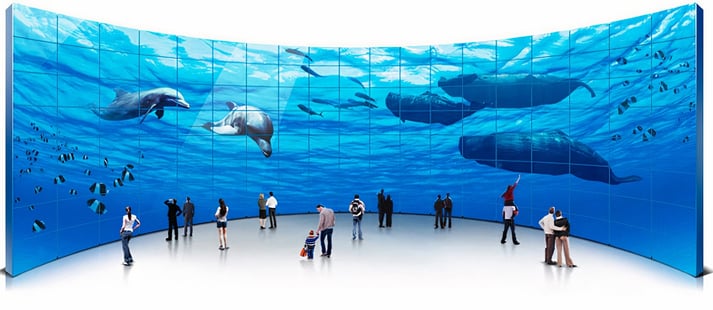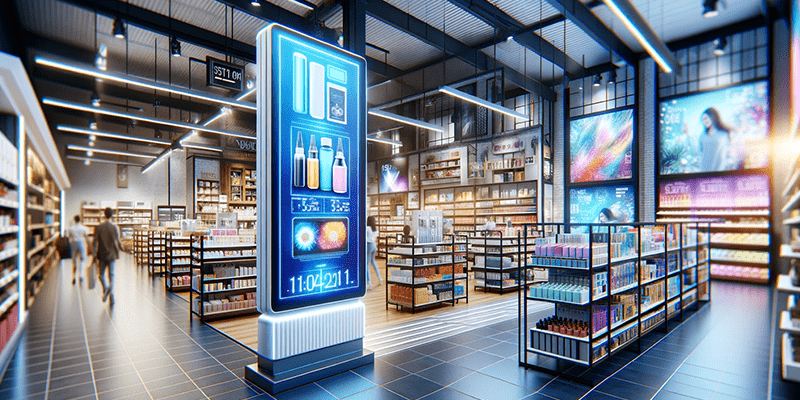
As you all know, retail is a highly dynamic and challenging environment. Which is why attention has recently been diverted towards innovative channels that transform brands’ strategies to interact with consumers in a physical shopping environment.
This prime focus aims to reach customers in unique ways and create different experiences within brick and mortar, away from the perfect world of e-commerce.
In the course of developing this retail “story”, there comes a chapter that has proven to be crucial—one which breaks conventions and strives to transform in-store practices into unparalleled heights.
Without further teasing your curiosity, let us introduce you to digital signage in retail. While absolutely not a new approach, its transformative potential has recently unfolded broad horizons within the industry.
So stay with us until the end of this article to find out exactly how your enterprise can benefit from it!
What is Digital Signage in Retail?
Digital signage as a whole refers to LCD monitors, screens, projection, and LED walls, all serving as a medium for information display, marketing, and advertising.
It can show various content, such as web visuals, cinematic displays, restaurant menus, marketing messages, dynamic imagery, and navigational guides.
Signage in retail refers specifically to the application of digital broadcasts, mainly through television screens, used for message and advertisement delivery within a given store premise.
A fantastic example of an innovative digital signage solution for retail is the YoYo Lift & Learn. This cutting-edge technology combines Near Field Communication (NFC) tags with MagicINFO, transforming signage networks into dynamic experiences. With an NFC-reader, a NFC-chip, MagicINFO Player, and YoYo software, this solution becomes versatile for any industry.
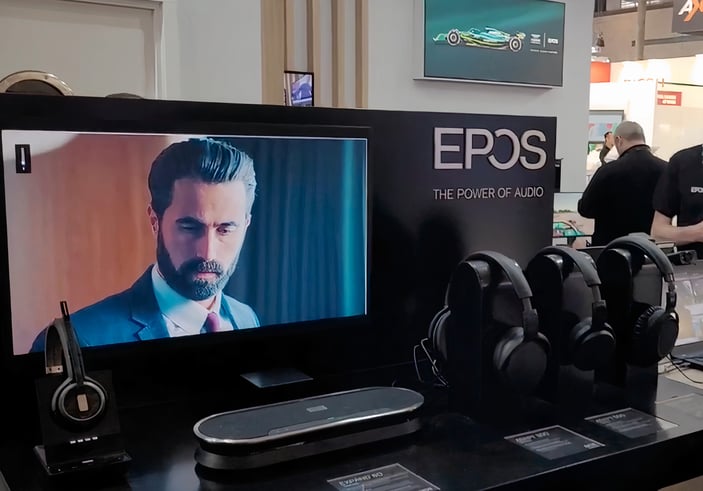
Imagine picking up a product from a shelf, and the screen instantly displays relevant information. This interaction creates a new way for customers to explore products—simply lift the item, and the corresponding content appears on the display.
You can also reverse the process by placing the product in a designated spot, known as the landing zone, to view information. This fusion of digital signage with Lift & Learn holds the potential to enhance ROI, offering endless possibilities for product branding and customer experience.
Types of Digital Signage for Stores
Below, we will explore some key types of engaging digital signage that can elevate your in-store communication:
Digital Displays
Digital displays have become a cornerstone of modern in-store marketing. The versatility of these displays allows them to serve various purposes in the retail sector.
An essential application of digital displays in retail is product promotion. If strategically placed throughout the store, digital displays can be very powerful tools for communication (if also armed with targeted, high-quality content, of course). They can effectively communicate the value and features of a brand’s product/service, leading to impulse buys and increasing sales.
In-store communication screens can also serve a dual purpose. For customers, they can provide essential information such as store layouts, promotional events, and product locations. For employees, they can be really invaluable when it comes to internal communication, as they can display schedules, corporate announcements, and training information.
And the best part is – you can customise, update, and schedule the displayed content remotely anytime.
Wayfinding Signage
Wayfinding signage can be addressed as a user-friendly tool that offers a self-service approach, allowing audiences to interact with touchscreen maps, donor boards and other elements. It can help craft experiences that resonate with people, address challenges, enhance information dissemination, and provide entertainment.
With cutting-edge technology, interactive wayfinding systems go beyond traditional maps, offering engaging directories that simplify visitor navigation. They play a crucial role in guiding customers through complex environments like multi-floor buildings. Additionally, they enhance visitor satisfaction, reduce confusion, and make an unforgettable first impression.
Voice-activated wayfinding, another innovative offering, uses speech recognition to facilitate hands-free interaction, enhancing customer experience and reducing the spread of germs. This system can be added to both new and existing projects.
Video Walls
Video wall technology can fundamentally change the way retailers interact with their customers.
LCD video walls, for example, are known for their sharpness and versatility, which provide a striking platform for showcasing products and promotions. They are composed of multiple screens in a grid formation and offer a large-scale, captivating visual experience. It is an ideal way to draw in and engage customers.
LED video walls bring a new dimension to retail displays with their bright, vivid colours and high-resolution capabilities. Their ability to adapt to various lighting conditions makes them perfect for both indoor and outdoor retail settings.
Mosaic video walls, on the other hand, break the mould of traditional display formats. They provide retailers with an innovative way to present content. With the ability to create various shapes and sizes, these walls offer a unique and artistic approach to digital signage.
Menu Boards
Digital menu boards offer an appealing and customizable platform that allows restaurants, coffee shops, quick-service restaurants (QSRs), and other food establishments to streamline menu management.
One of their many benefits is to provide an intuitive interface for creating and editing content. The flexibility to update menus wirelessly within minutes ensures that any changes in pricing, items, or special offers are reflected promptly, keeping information up to date.
Some advanced programming allows for different playlists, like morning, lunch, or dinner menus, to be displayed at designated times to ensure daily relevancy.
Another great advantage is their sustainability. By eliminating the need for printed menus, digital boards help reduce both print costs and waste. Additionally, they help businesses comply with evolving regulations, such as FDA requirements.
Kiosks
A kiosk is a small, mobile, and portable digital sign that aims to market or provide information in busy areas. The concept of kiosks has a long history that can be traced to the Middle East. Historically, they were small, open-air pavilions used as public gathering spaces.
In contemporary contexts, the term refers to various interactive and non-interactive booths often seen in retail stores, business offices, and public settings.
Ideal for high-traffic retail environments, kiosks are designed for commercial use, which ensures reliability and durability. Their interactive nature is great for engaging customers and attributing to their positive experience and image of the brand.
Benefits from Digital Signage in Modern Retail
We believe digital displays are more than just a technological upgrade for modern merchants. It could really be a game changer in how they connect with their customers. Below, we will get into digital signage’s most valuable benefits to retailers, from catching eyes and lifting sales to entirely transforming a customer’s shopping experience.
It Improves Customer Experience and Staff Satisfaction
Digital signage solves the problem of requiring traditional media such as posters or continuous interaction with staff. Of course, interpersonal communication in retail holds its value and this is often close to irreplaceable. But try to envision it from your employees’ perspective. It’s a busy season, queues of people are bustling, and there is a lot of pressure on your staff to attend to each customer promptly.
Now, picture the transformative effect of this technology in your store. It seamlessly provides each customer with tailored information to meet their needs. Let’s take it a step further – interactive kiosks for a fast self-checkout process. All this certainly ensures a smoother and more efficient shopping atmosphere for both customers and staff alike.
It Saves Time and Resources
Another benefit of digital signage is its cost-effective and time-saving nature in the long run. Imagine having to print 100 posters and circling around the entire store to put them in the relevant places. Or launching new products often and doing the above all over again. Furthermore, what if you had to change the price of 30 different products manually?
So, you see – signage is a marvellous way to optimise these processes. It allows you to change prices effortlessly or update product information in real-time anytime, without even being physically present. It makes things easier, faster, and way more enjoyable for everyone involved!
It Is Sustainable
Apart from its functional benefits, digital signage in retail contributes to sustainability efforts by replacing traditional paper advertising. This eco-friendly shift aligns with a commitment to a greener future by significantly reducing paper waste, promoting environmental responsibility, and fostering more sustainable business practices.
It Is Engaging
This technology also vastly outperforms traditional paper advertising in engaging customers. Key statistics highlight it garners 400% more views than static displays, a critical factor in its effectiveness in retail environments. Notably, 80% of customers have reported choosing to enter stores after seeing colourful digital displays, which further demonstrates its influence in driving foot traffic and potential sales.
This is additionally supported by the fact that 76% of American consumers have stated they entered stores they had never visited before simply because of the signage. This points to the strong impression digital signage can make on consumers, often leading to impulse purchases and new customer acquisition.
Beyond customer engagement, signage is also crucial in internal business communications. It is a preferred channel for about 50% of communication professionals, contributing to improved employee engagement and productivity. These advantages underscore its pivotal role in modern retail, surpassing traditional advertising methods in both customer attraction and operational efficiency.
McDonald’s menu 1993/2022
To prove our point and further confirm the truthfulness of the above research, we ask you to take a moment and analyse the image above.
On the left is a snapshot of a 1993 McDonald’s printed menu board, and on the right is a 2022 version featuring their latest digital signage. The contrast is indeed striking, highlighting not just the advancements in technology over three decades but also the leap in engagement and aesthetic appeal.
Digital displays do stand out with their vivid visuals and superior display quality, but the most important thing is that it revolutionises efficiency and practicality.
Consider the traditional printed menu: fixed prices, static images, and the inevitable need for reprinting if a change needs to be implemented. In stark contrast, the digital menu offers the flexibility of instant updates. Correcting prices or adding new products has never been easier and it is achievable within minutes and immediately goes live.
However, it is not about discrediting or dismissing traditional printed menu boards. Many restaurants still opt for these to evoke a retro charm, adding a nostalgic touch to their ambiance. That choice is as valid as any. Our focus here is to shed light on how digital signage has reshaped the industry in recent years, turning it into a “visual sensation” that captivates and attracts customers’ attention.
It Enhances Brand Consistency and Messaging Control
Digital information boards allow retailers to maintain consistent branding and messaging across all store locations. Centralised control ensures that all promotions, campaigns, and product information are uniform. This reinforces brand identity and ensures customers receive the same experience and information in every store.
Consistency is always crucial for building brand trust and recognition, which traditional methods might struggle to maintain due to the need for individual updates at each location.
Cost of Implementing In-Store Digital Signage
The overall cost of implementing in-store digital signage can vary significantly depending on several factors. The aspects impacting the price include the display screens, media players, mounts and cables, installation, software licensing, and content creation.
Each of these elements comes with different price ranges and options, such as consumer vs. commercial displays, display sizes, hardware quality, and software features.
Additional costs may include IT support, maintenance, and depreciation. Specific business needs, like the system’s quality and scale, and the content’s complexity influence the overall cost.
If we had to go with a rough estimate:
- Central to the setup, the display screens can range from €276 to €5000, depending on size and quality.
- Media players, essential for content display, vary from basic models, around €30, to advanced options, up to €700.
- Managing content software typically runs on a subscription model, costing between €10 and €50 per month.
- Installation charges depend on the system’s complexity, ranging from €200 for simple setups to €2000 or more for extensive installations.
- Content creation costs, including design and production, can be charged hourly, generally between €15 and €25.
- Maintenance, a recurring expense, varies greatly but can go up to €500 annually, depending on the system’s complexity and the service level required.
Best Practices in Digital Signage for Retailers to Utilise
Without a doubt, in the ever-evolving world of retail, your primary objectives would be to ensure smooth business operations and maintain customer satisfaction.
Yet, what is important is to recognize that there isn’t a one-size-fits-all formula for guaranteed success in this industry. However, adopting certain best practices can significantly improve your chances of achieving your business goals.
Let’s take a look at some of them:
Make Sure You Set Clear Objectives to Follow
First and foremost, begin by defining what you want to achieve with your digital signage. Is it boosting sales and optimising internal processes? Or maybe promoting new products and enhancing customer experience?
Having clear goals really helps tailor content effectively. And understanding your audience’s needs and preferences is more than crucial in this aspect.
Work on Developing an Exceptional Content Strategy
We are sure you have heard the popular phrase “Content is king” by Bill Gates. Interestingly, in 1996, Gates wrote an essay with that title and has since changed the course of digital marketing. He suggested most of the funds generated on the internet would come from content, and he wasn’t wrong.
View your content as your secret weapon to success. Don’t forget to update it regularly to keep it fresh, relevant, and engaging. Maybe even consider employing content management solutions to streamline this process.
Another aspect to consider is tailoring your content based on the location of the digital signage. For high-traffic areas, concise messages work best, while in waiting areas, more detailed content can be effective. At the point of sale, use content that encourages last-minute buying decisions or promotes loyalty programs.
Use Vivid Visuals for Better Impact
The design of your digital content is another critical aspect and it should be clear and eye-catching. Use legible fonts, high-contrast colours, and compelling visuals. Align images and text in a way that’s easy for viewers to process.
Also, we suggest implementing the 60-30-10 colour rule for balance and harmony in your design. This principle is a handy trick originally derived from interior design.
Think of it as a colour guide for creating a pleasing look. You use your primary colour for about 60% of the space, a secondary one for 30%, and a punchy accent colour for the remaining 10%.
This method has been proven to work best, as it naturally balances the colours in a design creative, making everything look structured and easy on the eyes.
Formulate Compelling Headlines and CTAs
Your digital signage should grab attention and drive action. Use creative and concise headlines. Include strong calls-to-action (CTAs) that are relevant and easy to follow, nudging customers towards desired actions.
Stick to Clarity and Brevity
Adhere to the 3×5 rule – three lines of text with five words each, or vice versa. This ensures your messages are easily digestible. Utilise an information hierarchy to structure your content effectively.
Come Up With a Schedule for the Content and Rotate
Determine the optimal duration for each message and schedule content loops accordingly. Regularly update and rotate content to maintain interest and relevance. Consider the time of day and customer demographics in content scheduling.
Evaluate and Adapt
Continuously monitor the effectiveness of your digital signage. Solicit customer feedback, track engagement levels, and use analytics to measure performance. Use these insights to refine and improve your content strategy.
Digital Signage Real-World Examples
Coca-Cola
Coca-Cola is renowned for its innovative and engaging advertising campaigns, and their use of digital signage is no exception. They have consistently leveraged this method to create interactive and memorable consumer experiences. Here are some notable aspects of it:
- Times Square Billboards: Coca-Cola’s displays in Times Square, New York, are a prime example of their cutting-edge advertising. The enterprise has utilised one of the largest digital billboards in Times Square, featuring a 3D robotic display that brings their advertisements to life with moving elements. This billboard stands out for its ability to engage with the high-volume pedestrian traffic in the area.
- Interactive Campaigns: The company had employed touch-screen technology in digital signs that allow passersby to create and personalise their own Coke bottles. These campaigns often integrate social media, encouraging users to share their experiences online.
- Augmented Reality Experiences: In some campaigns, Coca-Cola has combined digital signage with augmented reality (AR) to create immersive experiences. One notable instance is when they transformed a regular vending machine into an AR experience where users could see virtual polar bears reacting to their beverage choices.
- Eco-Friendly Messaging: The brand has also used digital billboards to convey eco-friendly messages. In certain campaigns, Coca-Cola leveraged signage to promote recycling and sustainability initiatives, demonstrating their commitment to environmental issues.
- Global Sporting Events: During major global sporting events like the FIFA World Cup and the Olympic Games, Coca-Cola has used digital signage to display live scores, highlights, and dynamic content related to the event, thereby engaging with sports fans in real-time.
- Seasonal Campaigns: Coca-Cola’s digital boards often feature seasonal campaigns, especially around Christmas, with their iconic “Holidays are Coming” adverts. These displays are designed to evoke nostalgia and associate the brand with festive cheer.
Samsung
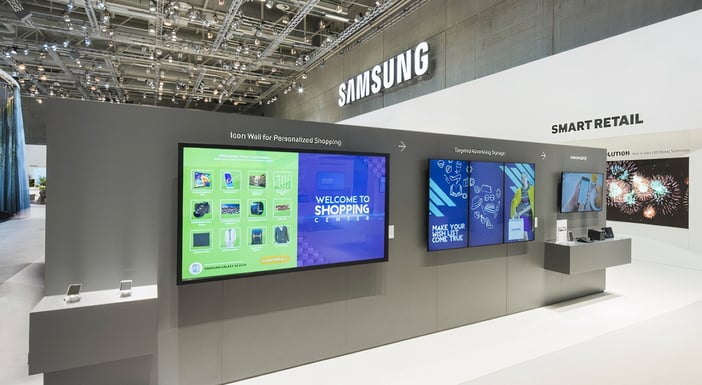
Samsung, a global leader in technology and electronics, has made significant strides in digital signage, both as a provider of signage solutions and in utilising these technologies in their marketing and retail strategies. Here are some examples of their involvement:
- Retail Store Displays: Samsung’s retail stores often feature state-of-the-art digital signage to showcase their products. These displays demonstrate features, user guides, and promotional content.
- Interactive Kiosks and Displays: The company has implemented interactive digital kiosks in their stores to allow customers explore products through touch screens. This technology allows customers to compare models and even see how a product would look in their home.
- Outdoor and Indoor LED Displays: Samsung develops and instals massive LED displays in high-traffic areas and at prominent events. These displays, known for their brightness, clarity, and energy efficiency, showcase high-resolution advertisements and branding content.
- Content Management Solutions: The manufacturer also provides integrated content management solutions that make it easier for businesses to deploy and manage their display information. The MagicINFO software, for example, offers features like scheduling, content creation, and remote management, allowing for dynamic and flexible content display.
- Use in Corporate Environments: Beyond retail, Samsung also utilises signage solutions in corporate settings, providing tools for effective communication and collaboration in business environments, such as digital whiteboards and meeting room displays.
BMW
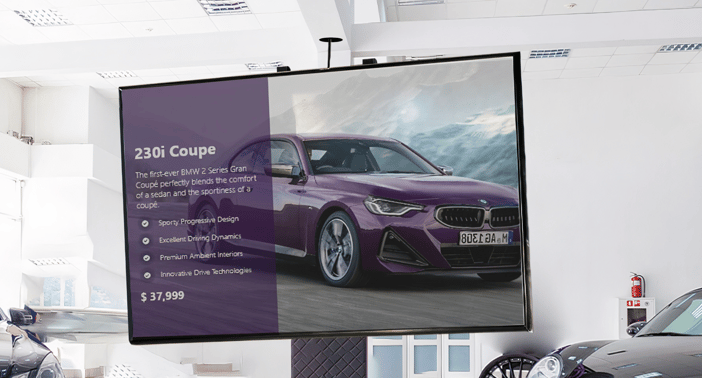
The renowned luxury car manufacturer, BMW has effectively incorporated digital signage into its marketing and customer service strategies, particularly in their showrooms and at various events.
- Showroom Displays: BMW showrooms are equipped with high-quality displays to showcase the latest car models, highlight features, and offer virtual test drives. This approach allows potential buyers to explore different aspects of a car, including colour options, interior features, wheel design, and technological innovations in a simulated environment.
- Digital Service and Maintenance Tips: BMW uses digital displays to give customers service and maintenance information. For example, some showrooms use signage in waiting areas to inform customers about the status of their car’s servicing, estimated waiting times, and other relevant details.
- Event and Exhibition Displays: At auto shows and exhibitions, BMW utilises large digital displays to attract visitors and showcase their latest vehicles and innovations. These displays often feature high-quality videos and animations that highlight their cars’ design, performance, and technology.
- Interactive Configurators: Some BMW showrooms offer digital configurators, allowing customers to build and personalise their car on a large screen. This process includes choosing the model, engine type, exterior colour, interior features, and additional accessories.
- Customer Engagement and Feedback: The manufacturer also uses digital signage to engage customers, collecting feedback in select locations. This can include interactive surveys and feedback forms that customers can fill out on digital screens after their showroom visit or service appointment.
EPOS
EPOS, renowned for its premium audio solutions, faced a unique challenge in effectively demonstrating the superior features of its headsets, particularly its advanced noise-cancellation technology. The company sought an innovative way to showcase these features and create an immersive customer experience that would set its products apart in a highly competitive market.
The Solution: EPOS Audio Experience Zones
To address this, EPOS, in collaboration with MagicInfo Services, conceptualised and deployed the EPOS Audio Experience Zones – a series of interactive digital signage installations strategically located in key retail and enterprise environments.
Key Features of the EPOS Audio Experience Zones:
- Interactive Product Displays: Each zone featured a series of high-definition screens powered by MagicINFO, showcasing detailed product information, user testimonials, and technical demonstrations of EPOS headsets.
- Live Demonstration Modules: Customers could experience the headsets’ noise-cancelling capabilities in real time. Using MagicINFO’s interactive capabilities, users could adjust the ambient noise level and see how the headsets maintain audio clarity.
- Customised Content Scheduling: The software also enabled EPOS to schedule and update content remotely, ensuring that the most relevant and current product information was always on display.
- Sensory Engagement: The zones were designed to engage multiple senses, with visual, auditory, and tactile elements. This multisensory approach effectively communicated the superior quality of EPOS products.
- Data Analytics and Feedback Integration: Equipped with user interaction tracking, the zones collected valuable customer preferences and engagement data, allowing the brand to refine their marketing and product strategies.
Choosing the Best Digital Signage Solution for Your Store
When choosing the ideal digital signage solution for your store, consider one that meets your current needs but also supports your long-term business goals. Here’s a breakdown of what to keep an eye on:Content Management
Opt for a user-friendly solution that offers easy and efficient content management. You should be able to update content quickly and schedule it as needed. Cloud-based solutions are often preferred for their ease of use and remote updating capabilities.
Hardware Specifications
Carefully choose the right size and type of screens to match your store setup. Consider factors like the brightness, resolution, and orientation of screens. The hardware should be robust enough to handle continuous use in a commercial environment.
Software Features
The software should be a “multitasker” offering the functionality you need, such as interactive elements, integration with social media, or analytics to track customer engagement. Compatibility with existing systems is also a crucial factor.Location and Placement
Where you place your digital signage screens is also crucial. They should be in spots that naturally catch the eye but also complement the store’s layout. The initial idea is to use a strategic visibility that enhances the shopping experience rather than interrupting it.Budget Considerations
Set a realistic budget. Approach budgeting with a focus on both immediate and long-term costs. This includes the initial investment in hardware and software, as well as ongoing expenses for maintenance and content updates. It’s about smart financial planning.Scalability and Flexibility
Choose a solution that can grow and adapt to your business. It should be flexible enough to cater to changing needs, such as expanding to more locations or integrating new technologies.Technical Support and Training
Ensure that the provider offers reliable technical support and training for your team. It’s always good to have a partner who’s there to guide you through any technical challenges and ensure your team is well-equipped to manage the system.ROI and Analytics
Choose a solution that offers analytical insights. It’s important to understand how your digital signage is performing, what resonates with your customers, and how it’s impacting your business goals. Think of it as having a dashboard that guides your future strategies.
Wrap Up
This article has taken you through the essence of digital signage in retail, exploring its various types and benefits to modern retailers and guiding you in choosing the perfect solution for your store.
We explored some real-world examples from giants like Coca-Cola, Samsung, and BMW, showcasing how these brands leverage this innovative technology. We hope these were helpful for you to better picture how you want to be positioned in this dynamic market.
As a closing, we want to share that the journey through signage is indeed very exciting and filled with potential and innovation at every turn. As retail continues to evolve, digital signage stands as a beacon, guiding the way toward more interactive and personalised customer adventures.
Use it as more than a medium to display information. Ensure you create a dialogue with your customers, understand their needs, and deliver on your brand promise!
(January 24, 2024). Maria Georgieva – MagicInfo Service. Retrieved from https://blog.magicinfoservices.com/blog/harnessing-the-power-of-digital-signage-for-retail

